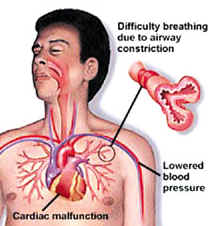Over 30,000 people suffer from life-threatening allergic reactions, with the number of deaths ranging from 12 to 50 annually. But knowledge of first aid for anaphylaxis can significantly help prevent serious complications arising from severe allergic reactions.
Allergic reactions are the body’s normal physiological response to any unknown substance or allergen. These reactions range from mild itch or sneezing to moderate swelling of mucous membranes to life-threatening allergic reaction, also called anaphylaxis.
Anaphylaxis occurs when there is widespread or systemic immune response to an allergen. It is an allergic reaction that involves more than one body system. It is often triggered by medication, food, insect stings, and natural latex. Without proper and prompt first aid for anaphylaxis, a person can die in minutes. While anaphylaxis affects only 2% of Canadians, it is important to note that one in every 10 Canadians have some forms of allergies. If not treated at early stage, these allergic reactions can lead to severe or even fatal reaction.
Recognizing anaphylaxis
An anaphylactic reaction can be difficult to recognize. It may start off as simple allergy with itching or tingling sensation or an unusual metallic taste. Other symptoms include hives, feeling warm, swelling of mouth and throat, and difficulty breathing. These symptoms often appear within minutes or a couple of hours after exposure to the allergen, but severe, lifethreatening reactions may develop several hours after.
Since exposure to an allergen can quickly develop into severe anaphylactic reaction and even death, people who experience any of these symptoms should seek emergency care or receive first aid for anaphylaxis immediately:
• Swelling of the throat and narrowing of the airways causing difficulty breathing
• Swelling of nasal passages or tongue
• Coughing, wheezing or high-pitched breathing
• Slurred speech, confusion, or anxiety
• Difficulty swallowing
• Localized swelling in certain body parts, particularly the face
• Redness or itchiness on the eyelids, lips, skin and other body parts
• Large hives or welts and skin eruptions
• Skin redness, especially if due to bee stings or insect bites
• Nausea and vomiting
• Stomach cramping and/or diarrhea
• Heart palpitations
• Bluish skin color, especially in the nail beds or lips
• Weak and rapid pulse
• Low blood pressure (dizziness, fainting, cold sweaty skin, or unconsciousness)
It is possible to develop initial symptoms that eventually go away, but then recur with more severe symptoms two to three hours later. This is known as “biphasic reaction,” and usually involves the respiratory system.
Responding in an anaphylactic reaction
Anaphylactic reactions can lead to death in just a matter of minutes. In most  cases, providing prompt and proper first aid for anaphylaxis prove to be life-saving. Here are steps you can take if you suspect someone is suffering from anaphylaxis.
cases, providing prompt and proper first aid for anaphylaxis prove to be life-saving. Here are steps you can take if you suspect someone is suffering from anaphylaxis.
• Call 911 or your local emergency number immediately.
• Check for a medical identification (such as a necklace, bracelet, card or tag) to
identify the possible trigger. Inform the emergency medical dispatcher about it.
• If the person is conscious, ask if he/she has an emergency medication for allergy. People who are known to have or at risk for anaphylactic reactions are often given self-injectable epinephrine. If epinephrine is available, administer as prescribed.
• If the person is unconscious, lay him/her flat and elevate the feet. Open the airway,and monitor breathing and pulse.
